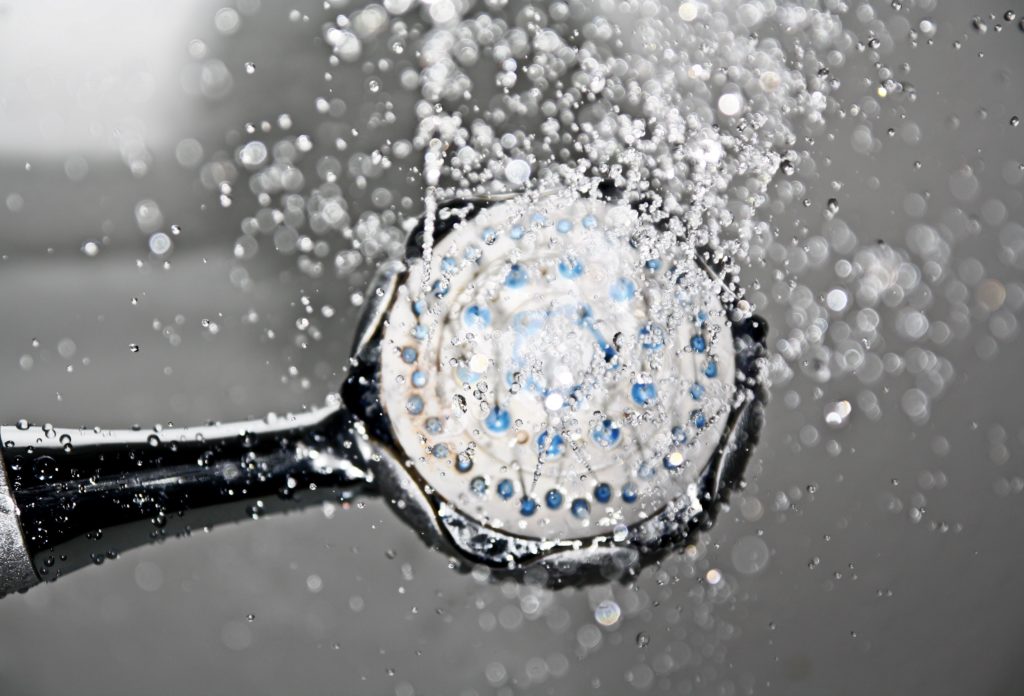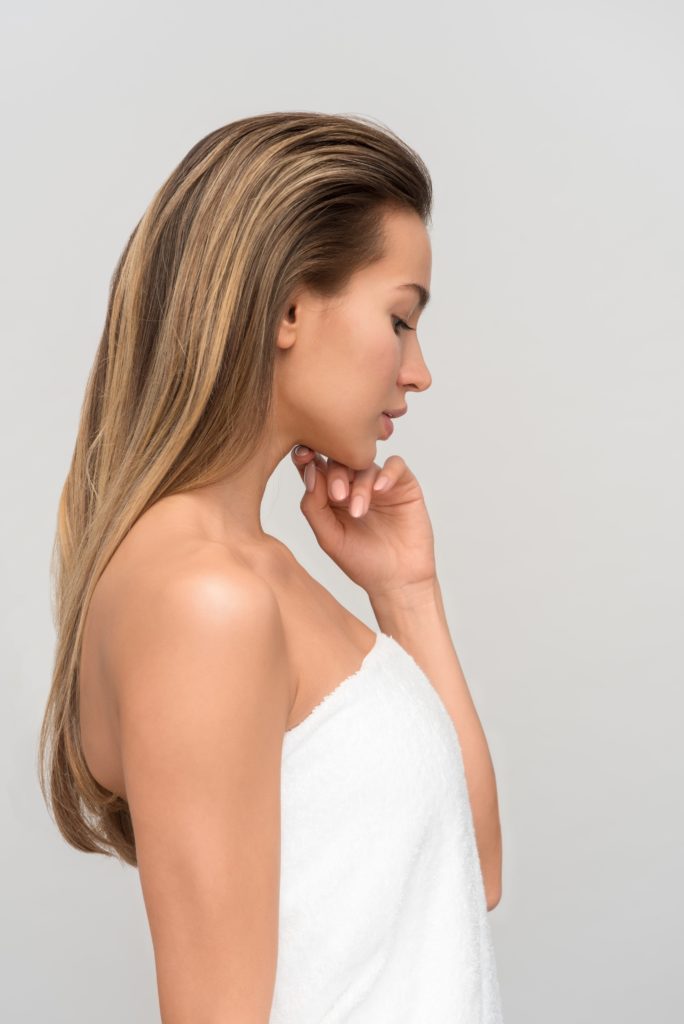Dry shampoo is a quick and waterless method of keeping your hair looking and smelling fresh.
Unfortunately, many people lean on dry shampoo to an unhealthy extent. Using dry shampoo too much may lead to cysts, clogged follicles, hair breakage and even mild hair loss.
How can you make sure your dry shampoo isn’t damaging your hair and scalp? Well let’s talk about what ingredients to avoid and what practices are healthy for your hair care.
What is dry shampoo?
The practice of dry shampooing has been around for hundreds of years. However, it has gained a lot of popularity over the past decade.
Dry shampoo is just what it sounds like — it gets rid of excess oil in your hair without having to wash it out with water. These products can be starch- or alcohol-based and they simply absorb oil to get rid of the greasiness.
Whatever it may sound like, dry “shampoo” is not intended for constant use.
Why do people use dry shampoo?
- Freshen up your “second or third-day” hair look and smell
- Keep your hair looking freshly blow-dried and fluffed
- Absorb oil — great for hair that starts to look greasy fast
- Can save hours of styling every week
How Dry Shampoo Damages Hair & Skin
Is dry shampoo bad for your hair and skin? If used incorrectly, dry shampoo can lead to several hair and skin conditions. Let’s break them down one by one.

Hair Loss and Breakage
Incorrect usage of dry shampoo can lead to issues with your hair and hair follicles.
A spray canister of dry shampoo often uses alcohol, which dries out your hair shafts. Dry strands are easier to snag and crack when you comb or style your hair. This leads to breakage and possible mild hair loss.
Dermatitis or Other Skin Problems
Dry shampoo misuse causes unwanted scalp conditions.
Does dry shampoo clog pores? If you spray too close to your scalp or allow dry shampoo to accumulate at your roots, dry shampoo can clog the follicles and pores on your scalp.
Dry shampoo traps bacteria. This can inflame your hair follicles, leading to cysts and pimples. These cysts and pimples can dry out if not treated. I see many patients in my clinic that come in for treatment of pimples on their scalp only for them to find out that simply eliminating using dry shampoo could get rid of them.
Finally, dry shampoo needs to be washed out. Just because the starch absorbs the oil doesn’t mean it’s gone. The oil remains absorbed in the starch, and, if left unwashed, can cause dandruff or seborrheic dermatitis, a condition that turns your scalp red and scaly.
If you have eczema or psoriasis, consult a dermatologist before using dry shampoo.
Does dry shampoo cause cancer?
Several dry shampoos may contain the mineral called talc. In its natural state, talc can contain asbestos, which can be associated with some cancers. However, cosmetic talcum powders are no longer allowed to contain asbestos when manufactured or sold in the United States.
A 2014 study indicated that talc in powder used on the genitals brought a slight increase in ovarian cancer risk.
In 2018, Johnson & Johnson paid $4.69 billion to 22 women who claimed the asbestos in J&J’s talcum baby powder products caused them to develop ovarian cancer.
The American Cancer Society concludes, “For any individual woman, if there is an increased risk, the overall increase is likely to be very small. Still, talc is widely used in many products, so it is important to determine if the increased risk is real. Research in this area continues.”
In general, it seems from the data that it was the asbestos and not the talc itself that is the issue here, but most of my patients still avoid using talc powder anywhere on their body.
Using Dry Shampoo the Right Way
When used correctly, dry shampoo can be a quick and easy way to keep your hair looking and smelling fresh.
How many days in a row can you use dry shampoo? Use sparingly! In general, only use dry shampoo once or maybe even two days in a row if absolutely necessary. I don’t advise using dry shampoo hair products three days in a row. Try to limit your use to once or twice a week.
How do you use dry shampoo correctly? Dry shampoos come in spray canisters and containers that only contain the powder. I don’t advise using the spray canisters as they are likely to contain alcohol that dry out your hair more. When you apply the powerd, apply to your hair, not your scalp. If any shampoo accumulates near your roots, use your fingers (or a comb) to spread it towards the oily areas.

Is it better to use dry shampoo or wash your hair? More and more people are realizing that washing your hair every day is horrible for your hair. But washing with shampoo, conditioner, and water is still better than prolonged use of dry shampoo.
Part of the key here is that over-washing your hair is actually one reason you may be producing more oil than you want. If you can stand it, I suggest changing your habits to wean off everyday shampooing (dry or otherwise).
Whether headed straight to work from the gym, or straight to a date from a stressful day of work, dry shampoo can be used the right way to keep your hair the way you want it.
But remember, dry shampoo is to be used with a dry head — no moisture, no sweat. Make sure your hair and scalp are dry.
Natural & DIY Dry Shampoos
Some dry shampoos may contain nasty chemicals. However, there are more natural, more organic products on the market. Or, you can simply make your own dry shampoo.
Ingredients that I like:
- Arrowroot starch
- Kaolin clay
- Charcoal
- Aluminum-free baking soda
Ingredients that I avoid:
- LPG’s (liquefied petroleum gas), such as butane, propane, isobutane
- Siloxane, silicones, octamethylcyclotetrasiloxane
- Phenoxyethanol (avoid prolonged use)
- Cetrimonium chloride
- Parabens
- Sulfates
- Talc

DIY Recipe for Dry Shampoo
Making your own dry shampoo is pretty simple. Basically, you start with starch then add natural oils for the aroma.
Ingredients
- ¼ cup starch (rice starch or arrowroot powder)
- 1 teaspoon of cinnamon or cocoa powder (depending on your hair color, use starch only for blondes)
- 3-5 drops of essential oils (for natural fragrance)
Instructions on How to Make It
- Mix your starch and cinnamon/cocoa.
- Once thoroughly mixed, add a few drops of essential oils. Mix in the oils.
- Store in an airtight container
Instructions on How to Use It
- Dip your makeup brush in the powder mixture. Tap off excess powder.
- With your brush, apply the powder to your roots and the oilier parts of your hair.
- Do not rub the powder into your scalp.
- Brush your hair, root to tips.
- In five minutes, your hair should be de-oiled and ready to go!
Remember: Make sure there is no accumulation left over, especially at your roots or on your scalp.
How do you use dry shampoo correctly?
-
-
- Limit use to once or twice a week.
- Use two days in a row only in an emergency.
- Powder your hair, not your scalp.
- Wash out dry shampoo within a couple days.
- Hair and scalp must be dry for dry shampoo to be safe and effective.
-
What dry shampoo ingredients should you avoid?
-
- Butane, propane, isobutane
- Siloxane, silicones, octamethylcyclotetrasiloxane
- Phenoxyethanol
- Cetrimonium chloride
- Parabens
- Sulfates
In Summary
-
- Is dry shampoo bad for your hair and skin? If you use it too often or don’t follow the directions provided, dry shampoo can lead to some nasty hair and skin conditions.
- What is dry shampoo? Dry shampoo works to absorb oil and give hair that fresh blowout look and cleaner smell.
- Is dry shampoo damaging to hair? Dry shampoo misuse can lead to dry hair, which increases risk of hair breakage. Also, dry shampoo traps bacteria, which can lead to cysts and pimples, which can dry out and trigger hair loss.
- Is dry shampoo safe for your scalp? If allowed to accumulate at your roots, dry shampoo can clog your follicles and irritate your scalp. Also, leaving dry shampoo in your hair can lead to dandruff or seborrheic dermatitis.
- Does dry shampoo cause cancer? There is preliminary evidence that the asbestos that was found in some talc powders in cosmetics can be linked to ovarian cancer, so you may want to stay away from talc as an ingredient.
Sources
- Robbins, C. (2006). Hair breakage during combing. I. Pathways of breakage. Journal of cosmetic science, 57(3), 233-243. Abstract: https://www.ncbi.nlm.nih.gov/pubmed/16832574
- Terry, K. L., Karageorgi, S., Shvetsov, Y. B., Merritt, M. A., Lurie, G., Thompson, P. J., … & Cushing-Haugen, K. (2013). Genital powder use and risk of ovarian cancer: a pooled analysis of 8,525 cases and 9,859 controls. Cancer prevention research, 6(8), 811-821. Full text: https://www.ncbi.nlm.nih.gov/pmc/articles/PMC3766843/
- Gao, Z. X., Tang, M. D., & Yi, Y. Z. (1994). Preliminary study on health effects in the residents exposed to liquefied petroleum gas. Zhonghua yu fang yi xue za zhi [Chinese journal of preventive medicine], 28(3), 154-157. Abstract: https://www.ncbi.nlm.nih.gov/pubmed/7842871
- Dréno, B., Zuberbier, T., Gelmetti, C., Gontijo, G., & Marinovich, M. (2019). Safety review of phenoxyethanol when used as a preservative in cosmetics. Journal of the European Academy of Dermatology and Venereology, 33, 15-24. Full text: https://onlinelibrary.wiley.com/doi/pdf/10.1111/jdv.15944
